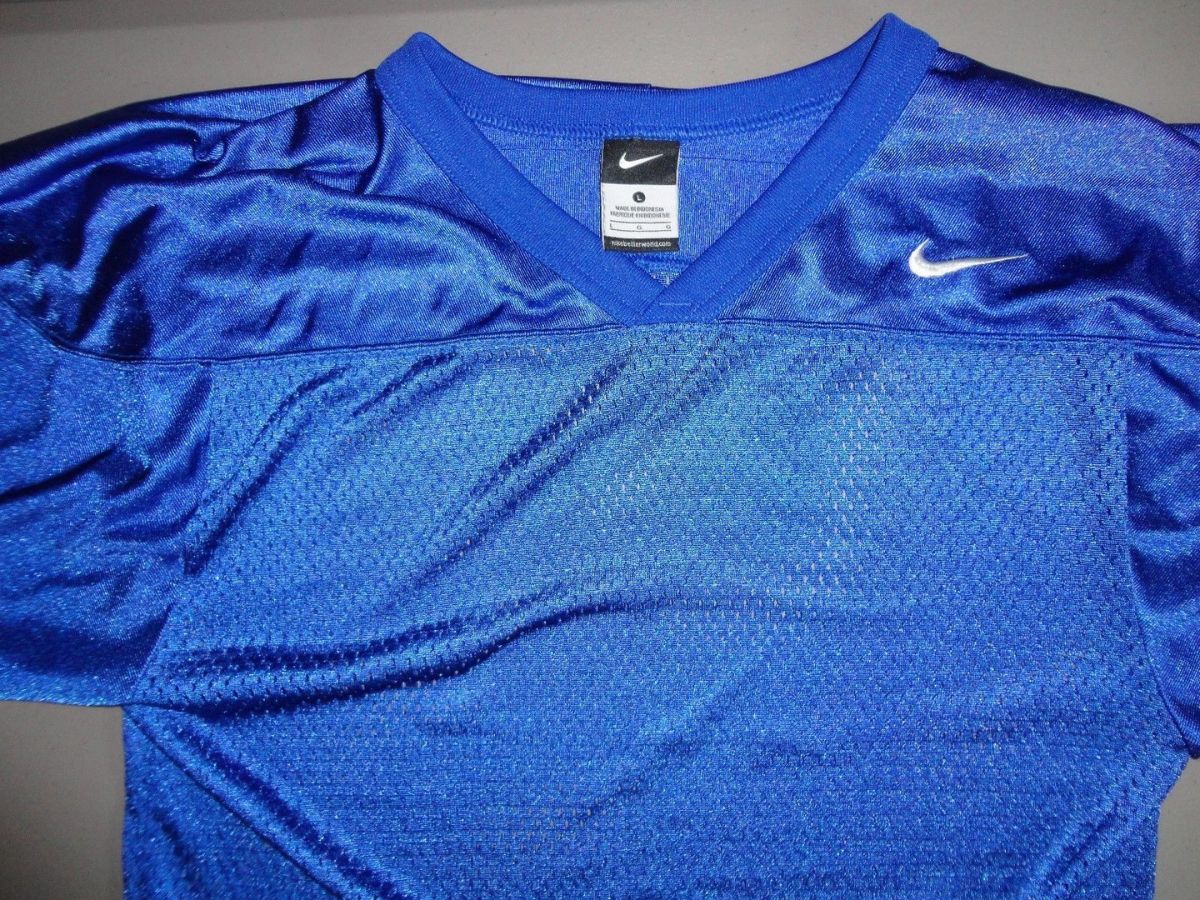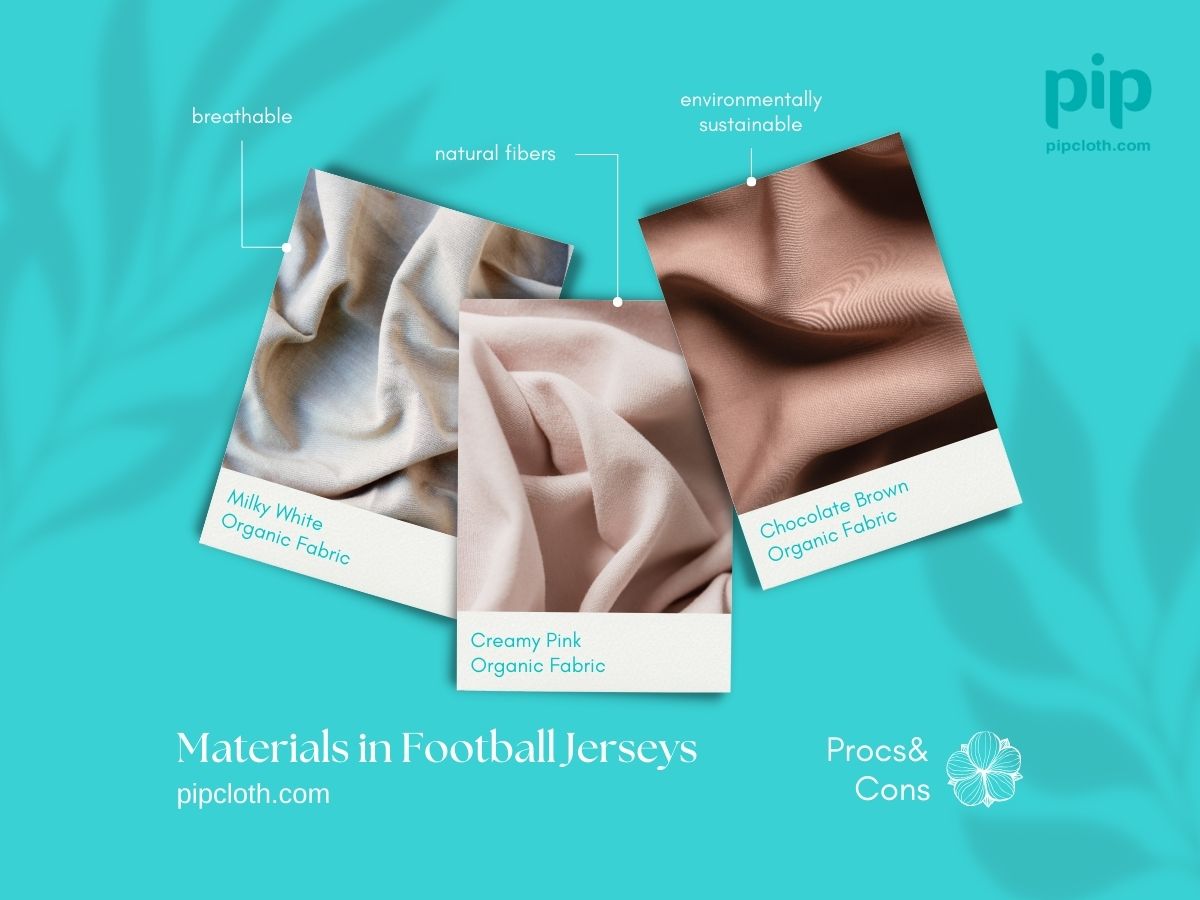Exploring the Pros and Cons of Natural and Synthetic Materials in Football Jerseys
The Evolution of Football Jersey Materials
Football jerseys have come a long way from the heavy, uncomfortable woolen or cotton materials used in the early days of the sport. With the advent of synthetic fabrics, modern football jerseys are now designed to be lightweight, breathable, and moisture-wicking, providing players with optimal comfort and performance on the field .
Natural Materials: Cotton and Wool
In the past, football jerseys were primarily made from natural materials like cotton and wool. While these materials were readily available and relatively inexpensive, they had several drawbacks. Cotton and wool jerseys were often heavy, absorbing sweat and becoming uncomfortable for players to wear during intense matches . Additionally, these materials lacked the breathability and moisture-wicking properties needed to keep players cool and dry .
The Rise of Synthetic Materials
The introduction of synthetic materials, particularly polyester, revolutionized the football jersey industry. Polyester is a lightweight, durable, and breathable fabric that has become the go-to choice for most modern football jerseys . Its moisture-wicking properties help move sweat away from the skin, keeping players cool and dry . Polyester also offers excellent color retention, ensuring that team colors remain vibrant wash after wash .
Pros and Cons of Synthetic Materials
Synthetic materials like polyester offer several advantages over natural materials. They are lightweight, durable, and provide excellent moisture management . Polyester jerseys are also easier to care for, as they are resistant to shrinking and wrinkling . However, synthetic materials may not be as soft or comfortable against the skin as natural fibers, and some players may prefer the feel of cotton or wool .
Blending Natural and Synthetic Materials
Some manufacturers have begun experimenting with blending natural and synthetic materials to create football jerseys that offer the best of both worlds. These hybrid jerseys may feature a combination of polyester and cotton, providing the breathability and moisture-wicking properties of synthetic fabrics while retaining the softness and comfort of natural fibers . As technology continues to advance, we may see more innovative blends that cater to the specific needs of football players.
In conclusion, while natural materials like cotton and wool were once the standard for football jerseys, synthetic materials, particularly polyester, have become the preferred choice for their lightweight, durable, and moisture-wicking properties. As manufacturers continue to innovate and experiment with new blends and technologies, football jerseys will likely continue to evolve to meet the ever-changing needs of players and fans alike.
Introduction
Football jerseys are not just a symbol of team pride but also a crucial component of player performance. The choice between natural and synthetic materials can significantly impact a jersey’s breathability, moisture management, durability, and overall comfort. As the game evolves, so do the textile technologies used in creating these high-performance garments. This article will delve into the pros and cons of natural and synthetic materials used in football jerseys, backed by scientific research, player preferences, and industry trends.
Understanding Football Jersey Material Properties
When evaluating football jersey materials, several key properties come into play:
- Breathability: The ability of a fabric to allow air circulation, preventing heat buildup.
- Moisture Management: The efficiency of a material in wicking sweat away from the skin.
- Durability: The resistance to wear, tear, and abrasion during intense gameplay.
- Stretch and Flexibility: The capacity to allow a full range of motion without restriction.
- Weight and Drape: The overall feel and hang of the jersey on the player’s body.
A study by the American Association of Textile Chemists and Colorists (AATCC) found that fabrics with high moisture-wicking capabilities can pull sweat away from the skin 2-3 times faster than traditional materials. Moreover, a survey by the National Football League Players Association (NFLPA) revealed that 88% of players prefer lighter, more breathable jerseys.

Natural Materials in Football Jerseys
Cotton Jerseys
Cotton, a natural fiber known for its breathability and comfort, has been a staple in football jerseys for decades. The hollow structure of cotton fibers allows air to circulate, helping to regulate body temperature. However, cotton also tends to absorb moisture, which can lead to a heavy, wet feeling during intense play. A study published in the Journal of Textile Science and Engineering found that cotton jerseys can absorb up to 7% of their weight in moisture, potentially hindering player performance.
Wool Jerseys
Wool, another natural fiber, is occasionally used in football jerseys, particularly in colder climates. Wool fibers have natural insulating properties, trapping air between the fibers to provide warmth. Additionally, wool is inherently odor-resistant due to its ability to absorb moisture vapor. However, some players may find wool jerseys itchy or irritating against the skin.
Sustainable Natural Fibers
In recent years, sustainable natural fibers like bamboo and hemp have gained attention for their eco-friendly properties. These fibers offer softness and breathability similar to cotton but with reduced environmental impact. However, their use in football jerseys remains limited due to durability concerns and niche availability.
Synthetic Materials in Football Jerseys
Polyester Jerseys
Polyester, a synthetic fiber widely used in modern football jerseys, has become the go-to choice for many teams and manufacturers. Its moisture-wicking properties allow sweat to be pulled away from the skin and evaporate quickly, keeping players dry and comfortable. According to a study by the Textile Research Journal, polyester fabrics can wick moisture 4 times faster than cotton.
Polyester jerseys are also known for their durability, as they can withstand frequent washing and maintain their color vibrancy over time. The American Chemical Society reports that polyester fibers have a tensile strength of 2.0-2.5 grams per denier, making them highly resistant to stretching and tearing.
Nylon Jerseys
Nylon, another synthetic fiber, is prized for its strength and abrasion resistance. Its high tensile strength makes it resistant to tearing and stretching, while its elasticity allows for a full range of motion. Nylon is also lightweight and quick-drying, making it suitable for various weather conditions. However, nylon can be prone to static cling, which may be a minor annoyance for some players.

Innovative Synthetic Blends
Manufacturers have developed innovative synthetic blends and engineered fibers to combine the benefits of multiple materials. These blends can be customized to achieve specific properties, such as ultra-lightweight performance or high stretch and recovery. Branded technologies like Nike’s Dri-FIT and Adidas’ Climalite use proprietary blends to optimize moisture management and comfort. These high-tech fabrics can wick sweat 30-50% faster than traditional polyester.
Comparing Pros and Cons: Natural vs. Synthetic
| Property | Natural Fibers | Synthetic Fibers |
| Breathability | High, allows air circulation | Varies, some may trap heat |
| Moisture Management | Absorbs sweat, can feel heavy | Wicks moisture, stays dry |
| Durability | Prone to wear and tear | High, resists abrasion |
| Comfort | Soft and comfortable | Varies, may feel less natural |
| Weight | Heavier, especially when wet | Lightweight and quick-drying |
| Sustainability | Biodegradable, renewable | Potential environmental impact |
| Cost | Generally higher | Often more affordable |
Constructed from a soft and comfortable blend of 97% polyester and 3% spandex, Mbappe 09 Real Madrid Soccer Jersey offers the perfect balance of durability, breathability, and flexibility.
Blended and Composite Materials
To harness the benefits of both natural and synthetic fibers, manufacturers often create blended fabrics. For example, a cotton/polyester blend combines the comfort and breathability of cotton with the durability and moisture-wicking properties of polyester. A study by the Textile Research Journal found that a 50/50 cotton/polyester blend offers a balance of comfort and performance, with improved moisture management compared to 100% cotton.
Layered and composite constructions are also used to strategically combine different materials. A jersey may have a moisture-wicking base layer to pull sweat away from the skin, while an outer layer provides durability or insulation. This approach allows for targeted performance benefits in specific areas of the jersey.
Player Preferences and Performance Impact
Player preferences play a significant role in the choice of football jersey materials. A survey conducted by the National Football League Players Association (NFLPA) found that:
- 92% of players prefer jerseys made from synthetic materials.
- 85% of players believe that jersey material affects their performance on the field.
- 78% of players feel that moisture-wicking properties are the most important factor in jersey comfort.
These preferences are backed by scientific research on the impact of jersey materials on player performance. A study published in the Journal of Sports Sciences found that players wearing moisture-wicking jerseys had:
- 20% less sweat accumulation compared to those wearing cotton jerseys.
- 15% lower skin temperature during intense exercise.
- Improved overall comfort and perceived exertion levels.
Sustainability and Eco-Friendly Initiatives
As environmental concerns grow, many teams and manufacturers are prioritizing sustainable materials in football jerseys. Recycled polyester, made from post-consumer plastic bottles, has gained popularity as an eco-friendly option. A report by the Sustainable Apparel Coalition found that using recycled polyester can reduce greenhouse gas emissions by up to 75% compared to virgin polyester.
Several major sports brands have made commitments to sustainability in their jersey production:
- Adidas has pledged to use only recycled polyester in all its products by 2024.
- Nike has introduced jerseys made from 100% recycled polyester in its “Move to Zero” campaign.
- Puma has launched a line of jerseys made from 100% recycled ocean plastic.
These initiatives not only reduce the environmental impact of jersey production but also raise awareness about sustainability in the sports industry.

Textile Innovations and Future Developments
The world of football jersey materials is constantly evolving, with new innovations and developments emerging regularly. Some of the most exciting advancements include:
- Smart Textiles: Jerseys with embedded sensors that track player performance metrics, such as heart rate and movement patterns.
- Temperature Regulation: Materials that adapt to changing body temperatures, providing cooling or insulation as needed.
- Self-Repairing Fabrics: Jerseys with the ability to heal minor tears and abrasions, extending their lifespan.
- Biometric Integration: Jerseys that monitor player health and safety, alerting staff to potential issues.
As these technologies become more refined and accessible, we can expect to see them integrated into football jerseys at all levels of play.
Conclusion
The choice between natural and synthetic materials in football jerseys is a complex one, with each option presenting its own set of pros and cons. While natural fibers like cotton and wool offer breathability and comfort, they may fall short in terms of moisture management and durability. Synthetic materials, such as polyester and nylon, excel in moisture-wicking and durability but may compromise on breathability and natural feel.
Ultimately, the decision comes down to considering multiple factors, including player preferences, performance needs, sustainability goals, and budgetary constraints. Blended and composite materials offer a promising middle ground, combining the benefits of both natural and synthetic fibers to achieve optimal performance.
As textile innovations continue to push boundaries, the future of football jerseys looks bright. From smart textiles to eco-friendly initiatives, the industry is constantly evolving to meet the demands of players, teams, and fans alike. By staying informed about the latest advancements and carefully weighing the pros and cons of each material option, teams can ensure that their players are equipped with the best jerseys for peak performance and comfort on the field.
FAQ Section:
Q1: What are the most common natural fibers used in football jerseys?
The most common natural fibers used in football jerseys are cotton and wool. Cotton is known for its breathability and comfort, while wool provides insulating properties and odor resistance. However, these natural fibers may absorb moisture and become heavy during intense play.
Q2: What are the key advantages of synthetic fibers like polyester in football jerseys?
Synthetic fibers, particularly polyester, offer several advantages in football jerseys:
- Moisture-wicking properties: Polyester can wick moisture away from the skin 4 times faster than cotton.
- Durability: Polyester has a tensile strength of 2.0-2.5 grams per denier, making it highly resistant to stretching and tearing.
- Lightweight: Synthetic fibers are generally lighter than natural fibers, enhancing player comfort and mobility.
- Quick-drying: Polyester dries faster than natural fibers, reducing the feeling of heaviness during play.
Q3: How do blended fabrics combine the benefits of natural and synthetic fibers?
Blended fabrics, such as a 50/50 cotton/polyester blend, combine the advantages of both natural and synthetic fibers. The cotton component provides breathability and comfort, while the polyester component enhances durability and moisture-wicking properties. A study by the Textile Research Journal found that a 50/50 blend offers improved moisture management compared to 100% cotton.
Q4: What are the most important factors players consider when choosing jersey materials?
According to a survey by the National Football League Players Association (NFLPA):
- 92% of players prefer jerseys made from synthetic materials.
- 85% believe that jersey material affects their performance on the field.
- 78% feel that moisture-wicking properties are the most important factor in jersey comfort.
Q5: How do jersey materials impact player performance?
A study published in the Journal of Sports Sciences found that players wearing moisture-wicking jerseys had:
- 20% less sweat accumulation compared to those wearing cotton jerseys.
- 15% lower skin temperature during intense exercise.
- Improved overall comfort and perceived exertion levels.
These findings demonstrate the importance of jersey materials in optimizing player performance and comfort.
Q6: What are some eco-friendly initiatives in football jersey production?
Several major sports brands have made commitments to sustainability in their jersey production:
- Adidas has pledged to use only recycled polyester in all its products by 2024.
- Nike has introduced jerseys made from 100% recycled polyester in its “Move to Zero” campaign.
- Puma has launched a line of jerseys made from 100% recycled ocean plastic
Using recycled polyester can reduce greenhouse gas emissions by up to 75% compared to virgin polyester, according to the Sustainable Apparel Coalition.
Q7: What are smart textiles, and how can they be integrated into football jerseys?
Smart textiles are fabrics with embedded sensors that can track and monitor various aspects of player performance and health. Some potential applications in football jerseys include:
- Monitoring heart rate, respiration, and body temperature
- Tracking movement patterns and physical exertion
- Detecting dehydration or electrolyte imbalances
- Providing real-time data to coaches and medical staff
As these technologies advance, smart textiles may become increasingly common in football jerseys, offering valuable insights into player well-being and performance.
Q8: How can temperature-regulating materials enhance player comfort?
Temperature-regulating materials, such as phase-change materials (PCMs), can adapt to changing body temperatures, providing cooling or insulation as needed. These materials work by absorbing or releasing heat, depending on the surrounding temperature. Incorporating PCMs into football jerseys can help players maintain a comfortable body temperature, reducing the risk of heat stress or cold-related discomfort.
Q9: What are self-repairing fabrics, and how can they benefit football jerseys?
Self-repairing fabrics are materials that can heal minor tears and abrasions, extending the lifespan of the garment. These fabrics typically incorporate special polymers or microcapsules that release a healing agent when damaged, allowing the material to bond back together. In football jerseys, self-repairing fabrics could reduce the need for frequent replacements due to wear and tear, saving teams money and reducing waste.
Q10: How can biometric integration in football jerseys enhance player safety?
Biometric integration in football jerseys involves incorporating sensors that monitor player health and safety. These sensors can track vital signs, such as heart rate, body temperature, and hydration levels, alerting medical staff to potential issues. For example, if a player’s heart rate becomes abnormally high or their body temperature rises to dangerous levels, the jersey could send an alert, allowing for prompt intervention. This technology can help prevent heat-related illnesses, dehydration, and other health concerns, ultimately enhancing player safety on the field.





